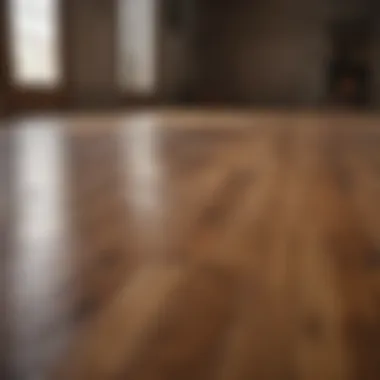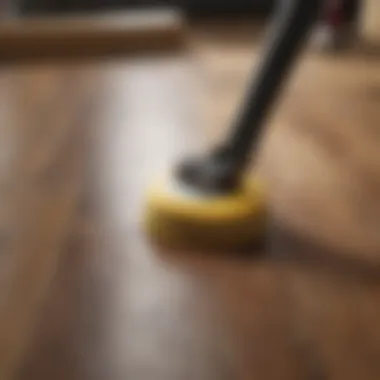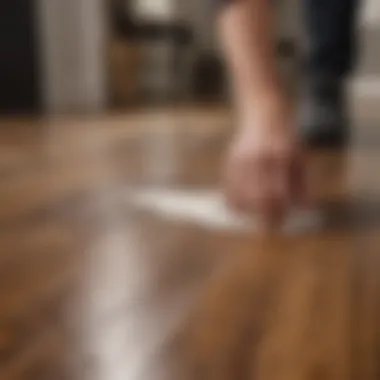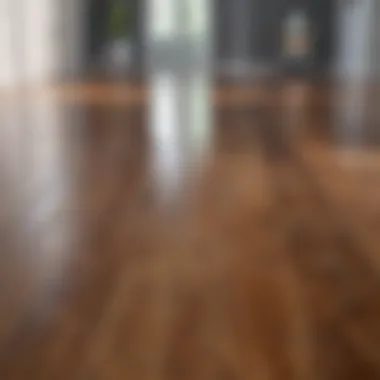Expert Tips to Remove Floor Wax from Hardwood Floors


Intro
The necessity of maintaining hardwood floors speaks volumes to the overall aesthetic within a home. Like any surface, these cherished wooden planks undergo wear and tear. Floor wax can accumulate over time, detracting from the charm of hardwood structures. Understanding how to effectively eliminate floor wax without damaging the natural beauty becomes paramount. This guide aims to shed light on methodologies that can safeguard your floors while restoring their polish.
Why Remove Floor Wax?
Removing floor wax is crucial for multiple reasons. First, excess wax builds up leads to a cloudy residue, often creating an unsightly surface. Secondly, if left unchecked, it may trap dirt and grime, causing further degradation to the wooden material beneath. Ultimately, maintaining a clean surface can prolong the lifespan of hardwood floors, allowing homeowners to appreciate their elegance for years.
Tip: Regular maintenance is advisable. Preventive measures can reduce the considerable accumulation of wax, simplifying the cleaning process in the long run.
Interior Design Tips
Though removing floor wax is primarily a cleaning task, the effects can be impactful on the overall decor. Clean hardwood brings vibrance and uniformity to any interior, enhancing the design elements in the space. Here are some insightful design considerations to bear in mind while you work on your flooring:
- Natural Light Interaction: A glossy surface reflects light beautifully. A more vibrant floor enhances the spectacle of natural light entering the room.
- Complementing Colors: Rich tones of hardwood floors pair seamlessly with many color schemes. When floors look their best, they can accentuate well-chosen wall colors and furniture arrangements.
- Spatial Arrangement Effect: Having tidy and gleaming floors allows homeowners to position furniture in a way that encourages flow and openness, contributing to an inviting atmosphere.
In summary, a commitment to cleaning the floors enhances not only their longevity but also the attractiveness of the home as a whole. This relationship brings about a dual benefit of aesthetic pleasure and practical upkeep.
Understanding Floor Wax and Its Impact
Floor wax has long been a popular choice for many homeowners seeking to enhance the look and durability of their hardwood floors. However, understanding what floor wax is and its implications for hardwood upkeep is crucial in maintaining the aesthetic and integrity of these surfaces.
What is Floor Wax?
Floor wax is a product used to create a protective layer on wood floors. Typically, it is composed of a combination of natural and synthetic materials, including waxes like carnauba and various solvents that aid in its application. The purpose of floor wax is to provide a glossy finish that enhances the visual appeal of wood while protecting it from day-to-day wear.
Applying floor wax can add a rich sheen to a floor, but it’s important to recognize its limitations. Over time, layers of wax can accumulate, leading to a dull, sticky surface that detracts from the wood's natural beauty.
Effects of Floor Wax on Hardwood
The impact of floor wax on hardwood can vary significantly depending on the frequency of application and the methods of removal.
- Enhanced Appeal: A freshly waxed floor can appear vibrant and polished. The shine provided by wax accentuates the wood’s grain and depth.
- Protection Against Stains: Wax serves as a barrier to minor moisture and stains, helping to maintain a clean look during regular usage.
Despite the benefits, there are notable downsides to over-waxing:
- Build-Up: Constant applications can result in an unsightly build-up, combined with dust and dirt, making the floor appear dirty even immediately after cleaning.
- Deterioration: If not removed properly, old wax may trap debris, potentially leading to the deterioration of the wood surface. Consequently, deep cleaning may become necessary, requiring extra effort and time.
- Slippery Surface: Accumulated wax can create a dangerously slippery surface, posing a risk for falls.
To sum up, while floor wax can enhance the beauty and usability of hardwood floors, understanding its effects is key for maintaining both the appearance and health of the wood in the long term. With the right information, homeowners can navigate the complexities of floor care effectively.
Why Remove Wax from Hardwood Floors?
Removing wax from hardwood floors is not just about achieving a clean surface. It delves into the aesthetic appeal of a home and prioritizes the longevity of hardwood material. Understanding why this task is essential can better inform homeowners on how to best maintain their flooring.
Aesthetic Considerations
The primary concern in house aesthetics is presentation. Wax accumulation can cause hardwood floors to appear dull and lackluster, obscuring their natural beauty. A well-maintained hardwood floor glistens and highlights the intrinsic variations in the wood grain, making any space feel more inviting.
Dirt and grime can often become trapped in the wax layer, amplifying the unattractive look of the floor. When decorative aspects like furniture or art pieces are around, dark or mottled spots let down the overall atmosphere, impacting how the entire room feels.
Thus, it becomes essential to remove any wax build-up. Not only does it restore the elegance of the wood, it furthers the consideration of achieving a cohesive and tasteful style throughout the interior space.
Preservation of Wood Quality


Wood is a living material requiring care and attention. Over time, accumulated wax can do irreversible damage. The wax disrupts the breathing capacity of the wood and can further lead to mold or mildew issues. Such complications necessitate expensive repairs in the future, considering the potential of hardwood to warp or deform if not properly cared for.
Additionally, maintaining the integrity of the wood surface ensures that any refinishing or sealing will yield better results. If the surface is filled with outdated wax, new finishes may not adhere properly, leading to an uneven layer of protection.
Pre-Removal Preparations
Before embarking on the task of removing floor wax, adhering to the proper preparatory measures is essential. Pre-removal preparations serve to safeguard the condition of the hardwood floors during the undoubtedly intricate process of wax removal. Preparing adequately enhances the likelihood of achieving a clean and polished finish without damaging the underlying wood beneath the wax.
Assessing the Floor Condition
Assessing the condition of the floor is an important step. Look for any signs of damage, including scratches, dents, or areas where the wood may be weaker. Ensure the floor is structurally sound, as a weak spot may present complications when removing wax. Additionally, evaluating existing finishes can help decide which removal methods to use. In some cases, certain methods may harm a finish that is already compromised. This assessment phase allows one to tailor the approach and methods used.
Gathering Necessary Tools
Having the right tools can significantly impact the effectiveness of wax removal. Below are essential tools needed for a successful wax removal process:
Soft cloths or mop
The use of soft cloths or a mop is critical. These items allow for a gentle application of solutions without scratching the wood. The key characteristic of soft cloths is their ability to absorb cleaning agents while preventing any potential scuffs on the surface of the wood. Soft materials minimize risk, making them a beneficial choice in wax removal. Ensure they are clean and dry to avoid residue transfer.
Wax remover solution
Choosing the correct wax remover solution is vital in this endeavor. The effectiveness of this solution can dramatically change how easily the wax is lifted from the floor. Many commercial options are available, but pay attention to ones that specifically mention use on hardwood. The unique feature of a caustic formula highlights its fast-acting capability. Yet, it is essential to test the solution first on a small corner to reduce the chances of adverse effects.
Plastic scraper or putty knife
Using a plastic scraper or putty knife reduces the chance of scratching. This tool gives control over the wax removal process, cutting away softened wax with precision. The benefit of plastic versus metal tools is avoidance of gouges. One disadvantage may be if the tool breaks under stress can prolong the process.
Bucket of warm water
A bucket of warm water plays an important role in loosening wax as multiple techniques call for the application of moisture. This step helps activate various cleaning agents dispersed over the surface. The warmth of the water can facilitate smoother operations. The bucket’s convenience in collection makes it a practical choice for this task. However, ensure that the water is not too hot as steam is not suitable for wood treatments.
Testing the Area
Testing a small, inconspicuous area prior to widespread application is crucial. This minimizes the risk of extensive damage by revealing how the floor reacts to removal products. Apply solutions sparingly and observe the outcome. Changes in color, texture, or any imperfections signal the need to adjust techniques or materials employed. This methodical approach reinforces a successful cleaning endeavor, safeguarding the integrity of the hardwood flooring.
Methods for Removing Floor Wax
Removing floor wax from hardwood surfaces can be a challenging task. However, it is essential to understand the various methods available. These methods not only help ensure the removed wax does not damage the floor but also maintain the hardwood’s aesthetic appeal. Different approaches can include commercial products as well as homemade solutions.
Using Commercial Wax Removers
Types of wax removers
Commercial wax removers are a popular choice for many homeowners due to their effectiveness. These products typically contain strong solvents that dissolve wax buildup quickly. Noteworthy brands include Minwax and Rejuvenate, known for their reliability in the industry.
These removers often come in various formulations, including liquid and spray types. The benefit of such wax removers is the ease of application and quick results. However, it is important to read the label carefully, as some products may contain harsh chemicals which can harm the wood’s finish. Understanding the ingredients can assist in making the best selection for your floor type.
Application process
The application process is not complicated but does require attention to detail. Most commercial wax removers come with a guide on how to apply.
Step 1: Sweep or vacuum the floor to remove debris.
Step 2: Apply the wax remover using a soft cloth or mop.
Step 3: Follow the instructions provided on the product to ensure effective removal.
Using a commercial remover can yield fast results with little effort, particularly beneficial if you have a large space to work with. However, it must be done correctly to avoid potential residue that might remain.


Homemade Solutions for Wax Removal
Vinegar and water mixture
Homemade solutions like vinegar and water mixture are an eco-friendly way to remove floor wax. The acetic acid in vinegar can effectively break down buildup without harsh chemicals. This option is also often more economical than commercial solutions.
Mixing equal parts distilled vinegar and warm water creates a cleansing solution that's easy to apply with a mop or cloth. One main advantage is that it poses less risk to the wood finish than stronger solvents. However, it might take a bit more effort when compared to commercial products. It’s ideal for regular maintenance rather than intensive removal tasks.
Alcohol-based solutions
Another effective homemade option is an alcohol-based solution, such as a mix of water and rubbing alcohol. This approach is quite efficient for tougher wax removal jobs. Isopropyl alcohol, for example, works on a molecular level to dissolve wax more aggressively.
While helpful, using alcohol poses some risks too. Prolonged use might affect the finish of your hardwood if misused. It’s essential to test a small, inconspicuous area before full application. Also ensure adequate ventilation to reduce fumes. An ideal blend is one-cup alcohol to three cups of water, when applying with a cloth.
Scraping Techniques
Correct methods for scraping
When wax spots remain despite using remvatovers, scraping is unavoidable. It is crucial to use a proper tool like a plastic scraper, which minimizes risks of denting or scratching the wood. Hold the scraper at a low angle for best results.
Initiate scraping carefully by applying limited pressure. Patients is crucial here, Kobe ge should gradually augment until you remove all wax remnants. This method requires some experience but can be beneficial for stubborn areas where time-consuming brushes fall short.
Minimizing wood damage
Minimizing wood damage during the scraping process is a significant consideration. Protecting the flooring itself is paramount. Strategies include testing the scraper on an inconspicuous spot before full application. Additionally, ensure not to apply excessive pressure as it can lead to irreversible damage such as scratching.
Maintaining a steady scraping angle ensures the wood remains unscathed. Finally, cleanliness after scraping is essential; sweep or vacuum again to remove any debris that could also scratch the surface. Better care leads to a longer lifespan for your hardwood floors.
Post-Removal Care
Post-removal care is crucial in ensuring the long-lasting beauty and integrity of hardwood floors. After the wax is cleared, it’s not only important to clean the surface but also to consider restoring the wood's finish. This phase helps in achieving a well-maintained floor that is not only visually appealing but also protected from future dirt, damage, or wear.
Cleaning the Floor Surface
Recommended cleaning products
When it comes to keeping your hardwood floor pristine, selecting the right cleaning products is vital. These products often contain gentle ingredients specifically designed for wood. This characteristic makes them less aggressive on the surface than common household cleaners which may leave residue or damage the finish over time.
Using pH-balanced wood cleaners, such as Bona Hardwood Floor Cleaner, helps maintain the natural oils of the wood while effectively removing any leftover debris. A unique feature of these products is they tend to be designed for regular use, ensuring the safety of your hardwood without sacrificing cleanliness. The choice of cleaner can alleviate concerns over chemical interactions that may arise from harsh substances. Sometimes this can be seen as advantageous, but an ill-prepared cleaner can lead to unsightly streaks or dull finishes.
Proper cleaning methods
Implementing the right cleaning methods is just as important as using proper products. For hardwood floors, a damp cleaning approach is often recommended over soaking. This means you must wring out the mop or cloth effectively, preventing excess water from seeping into the wood. This method is beneficial because excess moisture can warp or damage hardwood over time. Using a microfiber mop or cloth can ensure an adequate cleaning without risking moisture damage. Thoroughness prevents not only physical dirt build-up but also keeps bacteria from proliferating. A consistent cleaning routine will elevate the overall health and appearance of the floors.
Restoration of the Wood Finish
Choosing a suitable finish
Once the floors are clean, selecting a suitable finish is often the next step. Oil-based polyurethanes are a favored choice as they provide a strong protective layer while enhancing the wood's natural grain. This option is beneficial due to its durability, often requiring less frequent applications. However, planning is necessary. Such finishes can take longer to dry. Water-based finishes, on the other hand, dry quickly and are less smelly but may not provide the same level of durability as their oil-based counterparts. Weighing these characteristics allows homeowners to find a solution that will serve both aesthetic and functional purposes.
Application techniques
The technique used when applying the finish can impact the look and lifespan of hardwood floors. Techniques such as applying a finish with a foam roller can provide an even layer without bubbles or streaks. This approach to application ensures that every part of the floor receives uniform coverage, thus preventing uneven areas known for wear. Alternatively, a brush can offer precision in corners or intricate designs, but it may also introduce bristle marks if not used carefully. The advantages of rolling techniques are worth noting but should not dismiss brushes for more detail-oriented tasks. Practicing these methods while focusing on thoroughness leads to a polished surface which reinvigorates the overall appeal of hardwood floors.
Always remember, effective post-removal care can significantly prolong the lifespan and beauty of hardwood floors.


Safety Precautions When Removing Wax
Removing wax from hardwood floors requires careful consideration. This is not just about restoration of appearance; it’s also about ensuring the safety of both the individual performing the task and the materials involved. Adequate preparation can prevent accidents and enhance the overall effectiveness of the removal process.
Protective Gear
Using proper protective gear is critical in safeguarding oneself against harmful substances often found in wax removers. These chemicals can irritate the skin and eyes. Therefore, having the following items at hand is essential:
- Gloves: Use vinyl or rubber gloves to protect your hands. These will act as a barrier against any caustic solutions.
- Safety Goggles: Protect your eyes by wearing safety goggles. Wax removers may splatter when applied, so it is important to prevent exposure.
- Mask or Respirator: In enclosed spaces, a mask or respirator is advisable. This helps filter out fumes that can be harmful if inhaled, especially during prolonged contact with cleaning substances.
By using these protective items, you’re not only preventing injury but also making the experience more comfortable.
Ventilation Requirements
Ensuring proper ventilation during the wax removal process is equally important. Adequate airflow can reduce the concentration of fumes generated by chemical cleaners. Here are a few key considerations:
- Open Windows: If you are working inside, keep windows open. This facilitates air circulation and will flush out any coursing vapors.
- Utilize Fans: Positioning a fan to blow fresh air into the room or exhaust stale air out can be effective. This reduces the intensity of volatile organic compounds coming from the cleaning products.
- Choose Low-VOC Products: Where possible, opt for low-VOC (Volatile Organic Compounds) options. These products are less likely to emit harmful gases.
Ensuring ventilation is a proactive step that contributes to a safer working environment. Ultimately, the importance of these safety precautions greatly enhances not only personal well-being but also the overall success of the wax removal task. When it's done correctly, removing wax will result not only in clean hardwood floors but a safer home overall.
Maintenance Tips for Hardwood Floors
Maintaining hardwood floors is essential for longevity and visual appeal. Regular maintenance avoids issues like wax build-up, scratches, or dull finishes. Proper care makes it possible to retain warmth and beauty of the wood.
Regular Cleaning Routines
Establishing a routine for cleaning hardwood floors ensures they stay in optimal condition. Here are key components for effective cleaning:
- Use the right tools and products: Select a hardwood floor cleaner that leaves no residue. Microfiber mops are effective without scratching.
- Dust often: Regular dusting collects dirt and prevents scratching. Use a soft cloth or a dust mop to pick up particles.
- Wet cleaning: Use a damp mop with your chosen hardwood cleaner once every two weeks. Make sure not to soak the floor to avoid water damage.
Integrating a consistent cleaning schedule maximizes cleanliness while supporting the health of flooring.
Preventative Measures Against Wax Build-Up
Preventing wax build-up is vital for preserving hardwood floors. Here are some strategies:
- Limit the use of products with wax: Select sealers or cleaners specifically labeled as 'no-wax.’ This limits layering of products on your floor.
- Immediate cleaning after spills: Wipe up spills promptly. Liquids can be absorbed into wood if allowed to sit.
- Use area rugs: Placing rugs in high-traffic areas keeps dirt off the floors and reduces wear and tear.
Following these preventative steps can simplify maintenance and avoid complicated removal tasks later on.
An investment in regular maintenance not only reinforces the existing beauty of hardwood but also exforgettable extend its life span, creating long-term value.
End
In understanding how to effectively remove floor wax from hardwood floors, it becomes clear that meticulous attention to detail holds significant benefits. This final section emphasizes the idea that maintaining a clean hardwood surface goes beyond mere aesthetics; it is an investment in longevity and functionality of your floors.
Preservation of Quality
Regular removal of wax ensures that the natural beauty of hardwood flooring is visible and enhances the interior of your home. Wax buildup can obscure fine grain patterns and lead to an unattractive appearance over time. Thus, addressing the removal process promptly keeps floorings polished and vibrant.
Insightful Methods and Precautions
By exploring various methods including commercial wax removers and solutions traced from nature, the information presented guides homeowners towards informed decisions. It is crucial to choose a suitable method based on the specific type of hardwood in your space. Each approach inherently carries its unique considerations that could influence the chosen strategy.
Long-Term Considerations
The importance of proactive measures cannot be overstated. Establishing habits that prevent wax buildup can lead to lower maintenance costs and deeper satisfaction in the appearance of the wood over time. Routine assessments of wood quality can quickly indicate any areas requiring attention before buildup becomes substantial.
The balance between maintaining the aesthetic value of hardwood floors and prolonging their life should guide every homeowner's cleaning routine.
Both safety precautions and understanding the needs of your hardwood add layers of responsibility that complement the removal process.







